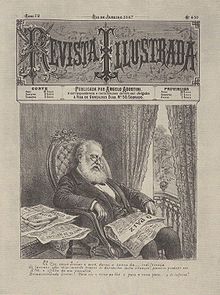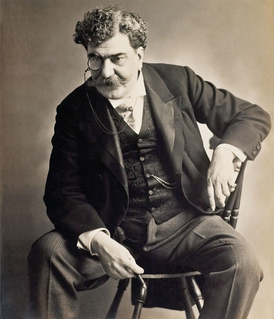
Rafael Bordalo Pinheiro was a Portuguese artist known for his illustration, caricatures, sculpture, and ceramics designs. Bordalo Pinheiro created the popular cartoon character Zé Povinho (1875) and is considered the first Portuguese comics creator.

The Confederation of the Equator was a short-lived rebellion that occurred in the northeastern region of the Empire of Brazil in 1824, in the early years of the country's independence from Portugal. The secessionist movement was led by liberals who opposed the authoritarian and centralist policies of the nation's first leader, Emperor Pedro I. The fight occurred in the provinces of Pernambuco, Ceará and Paraíba.

Angelo Agostini was an Italian-born Brazilian illustrator, journalist and founder of several publications, and although born in Italy, is considered the first Brazilian cartoonist.

Tauá is a municipality in the state of Ceará in the Northeast region of Brazil. In 2020 it had an estimated population of 59,062 people. It is one of the largest municipalities in the state, with an area of 4,018.188 square kilometres (1,551.431 sq mi).

Brazilian comics started in the 19th century, adopting a satirical style known as cartoon, charges or caricature that would later be cemented in the popular comic strips. The publication of magazines dedicated exclusively to comics, in Brazil, started at the beginning of the 20th century. Brazilian artists have worked with both styles. In the case of American comics some have achieved international fame, like Roger Cruz with X-Men and Mike Deodato with Thor, Wonder Woman and others.

Events in the year 1891 in Brazil.
The Night of Agony was a historical event in the Brazilian Empire, occurring in the pre-dawn hours of 12 November 1823, when emperor Dom Pedro I ordered the army to invade and dissolve the Brazilian constituent assembly. The assembly resisted for several hours, but in the end was dissolved and a few of its members were imprisoned and deported, including the brothers José Bonifácio de Andrada e Silva and Martim Francisco Ribeiro de Andrada, as well as Antônio Carlos Ribeiro de Andrada.
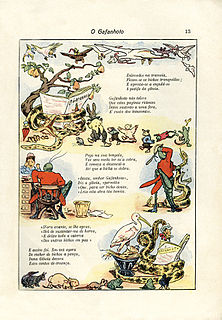
Portuguese comics are comics created in Portugal or by Portuguese authors. Rafael Bordalo Pinheiro, Carlos Botelho, and João Abel Manta are some of the most notable early Portuguese cartoonists.
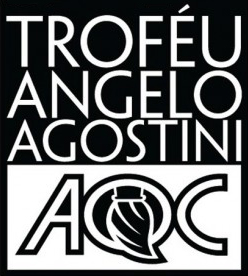
Prêmio Angelo Agostini, sometimes also called Troféu Angelo Agostini, is the most traditional comics award in Brazil. It was created in 1985 by the Associação dos Quadrinhistas e Caricaturistas do Estado de São Paulo (AQC-ESP), which still organizes the event today.

Francisco José do Nascimento, known as "Dragão do Mar", was an Afro-Brazilian raft fisherman (jangadeiro), pilot and abolitionist figure, who in 1881 led a strike of his fellow jangadeiros in the port of Fortaleza, state of Ceará, refusing to transport enslaved black people to be sold in Rio de Janeiro and other Brazilian provinces.

Preço Curto... Prazo Longo is the second album by Brazilian alternative rock band Charlie Brown Jr. Like its predecessor, it was released through Virgin Records on March 6, 1999, and produced by Rick Bonadio and Tadeu Patolla. Totaling 25 tracks, it is Charlie Brown Jr.'s longest studio album; in an interview, vocalist Chorão explained that Preço Curto... Prazo Longo was recorded out of necessity, so the band could have more repertoire for the set list of their shows. Six of the album's tracks had previously appeared as teasers in the promotional EP Aquele Luxo!, released some months prior.
Franco de Rosa is a Brazilian journalist, editor and comics artist. He started his career in 1974, with the comic strips Chucrutz and Capitão Caatinga, published in some Brazilian newspapers, such as Notícias Populares. From 1980, he started to make illustrations for newspapers and magazines. In 1984 he founded, alongside Paulo Paiva, the publishing house Maciota, which lasted until the 1990s. In 1997, he founded, alongside Dorival Vitor Lopes and Hélcio de Carvalho, the publishing house Mythos Editora. Rosa won the Troféu Jayme Cortez in 1990 and 1991, the Prêmio Angelo Agostini as best editor in 2003 and 2004 and as "Master of the National Comics" category in 2010.

Master of National Comics is one of the categories of Prêmio Angelo Agostini, the most traditional Brazilian award dedicated to comics that has been held since 1985 by Associação dos Quadrinhistas e Caricaturistas do Estado de São Paulo (AQC-ESP).
Nico Rosso was an Italian-Brazilian comic artist. Born in Italy, he studied with the masters Giacomo Grosso and Giovanni Reduzzi. He also taught Illustration and Costume History at the Bernard Semeriz School of Graphic Arts. He married Tina Billi in 1937 and had two children: Gianluigi Rosso and Valeria Rosso. He lost almost all of his possessions during World War II, moving to Brazil in 1947. In São Paulo, he started working in the Arts Department of Editora Brasilgráfica. After that, he became a freelance illustrator, drawing covers and comics for several publishers. Rosso has worked with all comic book genres, but his main works were in the horror genre, including the Coffin Joe comics. He was also a professor at the Escola Panamericana de Artes, which he co-founded. He retired in 1976 for health reasons and died in 1981 after suffering three heart attacks. In 1986, he was awarded posthumously with the Prêmio Angelo Agostini for Master of National Comics, an award that aims to honor artists who have dedicated themselves to Brazilian comics for at least 25 years.
Luiz Sá was a Brazilian comic book artist, caricaturist, illustrator, painter, scenographer and publicist. Born in the state of Ceará, he moved to Rio de Janeiro around 1929, where he began working for O Tico-Tico, the first comics magazine in Brazil. In O Tico-Tico, Sá created his most famous characters: the trio Reco-Reco, Bolão and Azeitona, considered the first legitimately Brazilian comic book characters and also the most popular of the magazine until its ending, in the 1960s. Sá was also one of the pioneers in Brazilian animation. In 1974, he contracted tuberculosis and, in 1979, he died of complications from the disease. In 1988, he was awarded posthumously with the Prêmio Angelo Agostini for Master of National Comics, an award that aims to honor artists who have dedicated themselves to Brazilian comics for at least 25 years.
Miguel Penteado was a Brazilian publisher, printer and comic artist. He started his career working at La Selva publishing house in the 1950s illustrating horror comic book covers. In 1959 he founded, together with Jayme Cortez, the publishing house Continental with the objective of publishing only Brazilian comics. It was in this publishing house that Mauricio de Sousa debuted in comic books with Bidu. After leaving Outubro due to disagreements with Cortez and other partners, Penteado founded the publishing house GEP, which, among other publications, was responsible for part of the material from Marvel Comics in Brazil from 1969, publishing for the first time in the country characters like Silver Surfer, X-Men and Captain Marvel. He gave up working as a publisher in 1972, after having several of his magazines censored by the then Brazilian Military Dictatorship, retiring in 1980. In 1990, he was awarded with the Prêmio Angelo Agostini for Master of National Comics, an award that aims to honor artists who have dedicated themselves to Brazilian comics for at least 25 years.
Maria Aparecida Godoy, also known as Cida Godoy, is a Brazilian comic artist and one of the pioneers in the horror and suspense genre in Brazil.
Ivan Wasth Rodrigues was a Brazilian painter and comics artist. He learned painting at the ateliers of José Wasth Rodrigues, Cid Affonso Rodrigues and Vittorio Gobbis, and also at the Escola de Belas-Artes de São Paulo. He started his professional career as a book illustrator for the Melhoramentos publishing house and doing advertising design. In the field of comics, he designed a two-part book for EBAL publishing house on the history of Brazil and the adaptation of the classic Casa-Grande & Senzala, by Gilberto Freire. For Freire's book, which talks about the period of slavery in Brazil, Wasth Rodrigues researched for five months the paintings of Jean-Baptiste Debret. In 2001, he was awarded with the Prêmio Angelo Agostini for Master of National Comics, an award that aims to honor artists who have dedicated themselves to Brazilian comics for at least 25 years.
Izomar Camargo Guilherme was a Brazilian comic artist. He started his career in the 1950s at La Selva publishing house. Among other children's characters, he created Zing Zong Crunch, the goblins Dingo and Dungo, the crazy duck Reco and the little native Bugrinho. Izomar also worked at Editora Abril with Disney comics in the 1960s, in addition to being art director and responsible for the publisher's comic book covers in the 1970s and 1980s. In 1992, he was awarded with the Prêmio Angelo Agostini for Master of National Comics, an award that aims to honor artists who have dedicated themselves to Brazilian comics for at least 25 years.
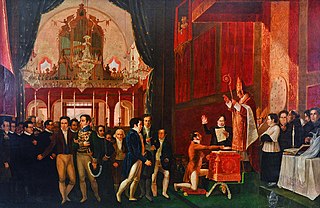
Regency period is how the decade from 1831 to 1840 became known in the history of the Empire of Brazil, between the abdication of emperor Pedro I on 7 April 1831 and the Golpe da Maioridade, when his son Pedro II was legally declared of age by the Senate at the age of 14 on 23 July 1840.
